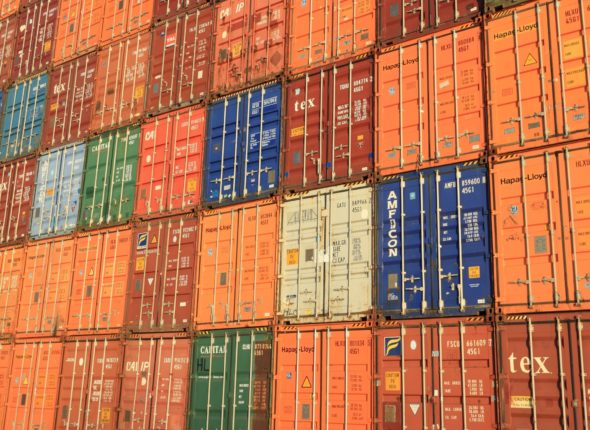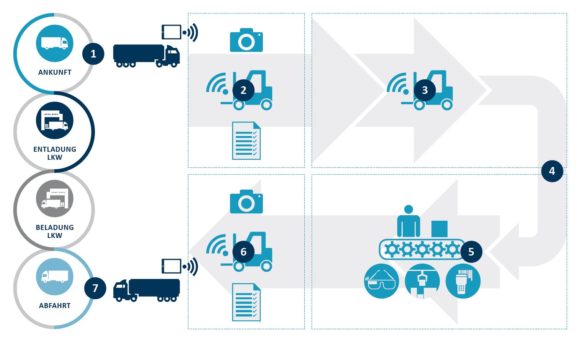Thanks to the possibilities of digital warehousing and the Industrial Internet of Things (IIoT), flexible and scalable warehouses can now be realized with real-time stocktaking, intelligent automation, AI analyses and robotic elements. There used to only be two possibilities for warehouses: Either you designed it flexibly and accepted the high manpower costs that it involved or you aimed for the best efficiency possible, which was only feasible in a fixed system.
Flexible OR efficient warehouse? Both!
When it came to warehouses, you used to have to choose: Maximum flexibility together with a lot of manpower or an efficient and automated warehouse. Manual and flexible warehouses need lots of manpower because they require strong personal commitment in lean management, as well as costly manual handling.
An efficient solution – the classic automated warehouse – requires considerable initial investment. If this warehouse is meant to work economically, then higher throughput and less flexibility are required. Technology-based redundancies due to automation solutions also represent a disadvantage.
Digital warehousing makes both a flexible and efficient warehouse possible. With SAP EWM in combination with SAP Yard Logistics and IIoT, fully automatic processes can be established.
Co-working: Robot and man
In the meanwhile, warehouse robots have become so advanced that they can work together with people seamlessly. While deploying a warehouse robot is always a project in itself, it will never be able to replace the work of a person. However, robots can be used in a three shift system and score points when it comes to cost-effectiveness.
Figure: Digital warehousing process example
Practical digital warehousing
CAMELOT Management Consultants have already implemented digital warehousing projects involving the switch from manual warehousing to warehousing with fully automatic processes. The following examples illustrate how the processes look.
Yard management and track & trace (1)
Trucks arrive in a distributed and planned manner. Adjustments are possible via drag & drop. The drivers’ mobile phones are used to track them on the yard. Alternatively, RFID pagers can be handed out at the gate, which indicate the correct time of arrival.
Upon the allotted timeframe, the drivers receive a message that tells them that they can enter the yard and which dock or unloading area they should use. As soon as the right RFID pager of mobile phone is identified, the integrated truck gate opens automatically.
Goods receipt and storage
(2) + (3)
When the driver arrives at the prescribed dock, the mobile phone or RFID pager is check to see whether the right truck is at the right dock. Then it opens automatically.
The forklift that unloads the truck is equipped with a barcode scanner or an RFID reader, which automatically identify the products that are to be unloaded. The forklift operators check for damage and that the quantities are correct. They then release the goods digitally.
SAP EWM displays the planned storage location on the mobile device. The position is again checked when the item is put into storage.
Retrieval, picking and packing area
(4) + (5)
For retrieval and replenishment, the next available forklift driver receives a transport order from SAP EWM. For process assurance, automatic scanning or RFID reading take place when an item is picked and when it arrives for packing.
Picking and replenishment are handled by the nearest available employee. SAP EWM shows the transport orders via Google Glasses. Barcode scanning and RFID reading are done via glove scanners.
In the packing area, packing is performed manually or with automatic solutions. SAP EWM displays the pack dialog. The shipping label can be printed automatically with or without an RFID tag.
Shipping and yard management
(6) + (7)
The truck drives to the allotted dock to be loaded. The position is checked via mobile phone or RFID pager. The integrated gate only opens for the right truck. The forklift drivers load the truck manually. The transport order can be displayed on the forklift with a barcode or RFID so that the cargo can be verified. A photo of each pallet and a photo of the complete load provide an addition safeguard for the process. The forklift driver signs the goods issue document digitally. The gate then closes automatically.
The driver returns the pager at the gate upon leaving the yard. Once the right pager is handed in or the right truck is identified via mobile phone ID, the gate opens.
Outlook
Thanks to new technological possibilities, many companies are switching to fully automatic processes and flexible automation solutions. From the strategy to implementation, one must take a broad view over all processes in order to profit from the benefits of both worlds in the end: a flexible and efficient warehouse.
We would like to thank Albert Peychal-Heiling for his valuable contribution to this article.


